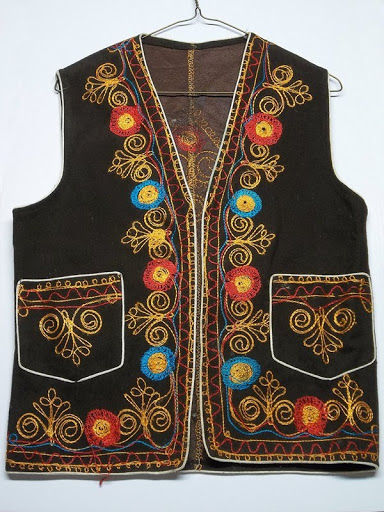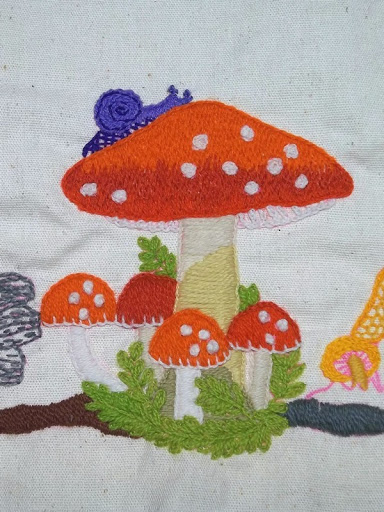(Continuing the topic of crewel embroidery, introduced in the previous post.)
 |
| A chain-stich sample, yarn on burlap |
I like to think of related stitches as “families”. We've looked at cross-stitches, running stitches and back-stitches previously in this way. The chain-stitch “family” is surely in the top three of important stitch families ― and is my personal favorite. The stitch is very old and very widespread, indicating that it may have been “invented” several times. It can be found in the oldest surviving embroideries of such diverse places as Afghanistan, Egypt, Nigeria, Greece, Russia, Scandinavia, France, Bolivia and Peru. A glance at the maps makes me suspect some of it spread from contact and trade with ancient Egypt, where some authorities believe it was derived from a sail-makers' stitch used to make the sails of small boats that traveled the Nile stiffer and more durable. But the pieces from Bolivia and Peru predate contact with Europeans by more than a thousand years.
Before we explore the many varieties of chain stitches, let's take a simple chain and see how it can be embellished. To make the chain, place your fabric in an an embroidery hoop and make it tight. Thread your yarn into a crewel needle (a thin needle with a large eye like a tapestry needle, but with a sharp point). Start with a waste knot (see the blog post for Sept. 24, 2013) on the surface of your fabric. Push your needle through the fabric and bring it back to the surface several inches from the waste knot. Holding the yarn aside with the thumb of your non-stitching hand, insert the point of your needle through the same hole where it came up. Bring the needle up a few threads ahead of where it went down. Loop the thread under the needle from left to right (or right to left if you are left-handed). As you pull gently on the yarn, it will begin to form a teardrop-shaped loop. Draw the yarn through until the loop is the size you want and the yarn lies flat on the surface of the fabric. (Don't leave the loop loose and floppy, but don't pull it too tight or the fabric will pucker.) Insert the needle in the same hole you just made and repeat the process. You have made the first two “links” of your chain. Continue until the chain is the desired length. Stitch the top of the last loop down with a tiny forward stitch, pointing the tip of the needle back under the completed stitches. Overcast (wrap) the yarn around several completed stitches to anchor it and cut it close to the stitches. Cut off the waste knot, pull the yarn to the back, thread it into your needle and overcast several stitches at that end. The back of your chain should be a straight line of back-stitches. Practice several lines of the plain chain-stitch.
 |
| Closeup of simple chain-stitch |
 |
| Another section of the crewel embroidery mushrooms |
 |
| Removing a thread to create a straight void |
Two things about chain-stitch usually require practice: keeping the line of stitches straight and making the “links” in your chain as alike as possible. To make this easier, I suggest that you start with a piece of fabric loosely-woven enough that you can easily withdraw individual threads. I've used wool, coarse linen, hop-sacking, and even burlap for this. You need to be able to gently remove a single thread completely without breaking it. Then draw out a thread every inch (2.5 cm.) or so before you put the fabric in the embroidery hoop. Stitching in the space where the thread once was will help you stitch a nice, straight line. You will be able to see and count the threads that cross the space. If you pass your needle under the same number of threads each time and use the same amount of “pull” (tension), your stitches should be fairly uniform. The tension on the fabric is important, too. Keep it stretched tight in the hoop. Adjust the hoop with the turn-screw as needed.
Not too many years before my time, girls and women made and framed “samplers” to show off their best stitchery. Now it is your turn to make a sampler. (Before you begin, you may want to review the stitches and terms shown on the Jan. 16, 2015 blog post.) Start by making a line of plain chain along each of the pulled thread lines that you made. Then try each of the seven variations I'm going to show you in the sampler below. I used 4-ply yarn, which is not ideal for embroidery, but I wanted to make big stitches that were easy for you to see and copy. The rows are as follows:
 |
| Chain-stitch with variations listed at left |
- plain chain stitch in medium blue;
- chain back-stitched with a smaller white yarn from link to link;
- chain with double-running stitch, alternating white and navy yarns link to link;
- entire chain whipped (overcast) with the white yarn;
- each side of the chain whipped with thin navy yarn, stitched one side at a time from center out;
- Pekinese stitch done in white through the entire chain;
- entire chain laced (threaded) with white yarn, with the loops then stitched down at the tops with white sewing thread;
- entire chain laced with white yarn, first from one end, then from the other (double-laced) and then couched (stitched down) with a contrasting yarn.
If you look carefully at the bottom of the first practice sampler (photo at the top of the post), you will see some stitches that look like flower petals. This is Detached Chain or Lazy Daisy stitch, one of the first stitches I learned as a child. Look at the demonstration and try it for yourself. The next time we touch on this topic, I will have a design for you that you can download and do these stitches on in your choice of colors.
Practice, practice, practice,
 |
| Embroidered vest, silk floss on wool |







